Contents
A Golden Retriever is said to be a sporting breed, strong and well-built. They were originally bred to aid in retrieving fallen prey for hunters residing in the Scottish islands back in the nineteenth century, hence the name ‘retriever’.
This included lots of heavy running, long-distance hiking, and swimming. Besides, retrieving in or around Scottish Highlands was a very physically demanding task, because of its mountainous landscapes dotted with streams, lakes, and ponds.
Although they are commonly used as pets these days, they still have the genetic temperament of working dogs and are kept very energetic and active. To keep your Golden Retriever happy and healthy, you need to provide enough exercise.
So this leads to questions like; how much exercise does a golden retriever need? What are the best exercises for Golden retrievers?
Well, luckily these questions are answered in this article, so do ensure you read to the end
First off, a poorly trained golden retriever will be destructive.
A golden retriever breed craves physical/sporting activity, in fact, Physical activity is needed. And when they do not get enough exercise, they store excess unused energy and their minds tend to become so boring that they just have to find a release.
They tend to become destructive, running around, digging, and chewing. They need to do all these to be able to act well again because they have much stored/unused energy. A few of them would even escape from their homes and gardens when it happens.
Many who kept saying that their ‘golden’ is acting abnormally are obviously not exercising them as required. They haven’t met up with the dog’s standard needs and have literally trained a golden that bounces off the wall while trying to release the stored energy.
Also, lack of exercise activity has an adverse effect on your golden retriever’s health
Golden retrievers are known to love food and eat whatever you feed them. They do this because they are an athletic breed that would need to spend lots of energy if they were to work on their primary assignment.
But when they are locked up at home, do a little exercise, and only occasionally take walks, they would still have all that food stored in them, turning into fat, leading to weight gain and poor health which may cause severe health challenges.
Of course, Golden Retrievers are not immune to obesity. And this is usually a mixture of their owners doing these things:
- Frequently falling for their cleverly begging routines. Irrespective of your golden’s age, they will still display their irresistible ‘puppy dog eyes’ when they see food around.
- Denying their pooch a sufficient amount of exercise.
It’s easy arithmetic to know that if your dog takes in more calories than the number of calories they burn, then they will gain more weight. So if your dog receives a lot of treats/table scraps, and is not receiving any exercise, they will add more pounds and you will probably have to place your golden retriever on a diet, and we honestly don’t like that!.
Obesity causes various problems, including heart disease, hip & elbow joint damage, high blood pressure, and an increased risk of diabetes.
Keeping your golden’s healthy is an important responsibility for a decent owner.
So How Much Exercise Does A Golden Retriever Need?
There is no correct answer to cover every individual dog, as it depends on their genetics, age, and their overall well-being.
Here is a detailed guide to best answer this question considering the various stages of the retriever’s life.
Required Amount of Exercise for a Golden Retriever Puppy
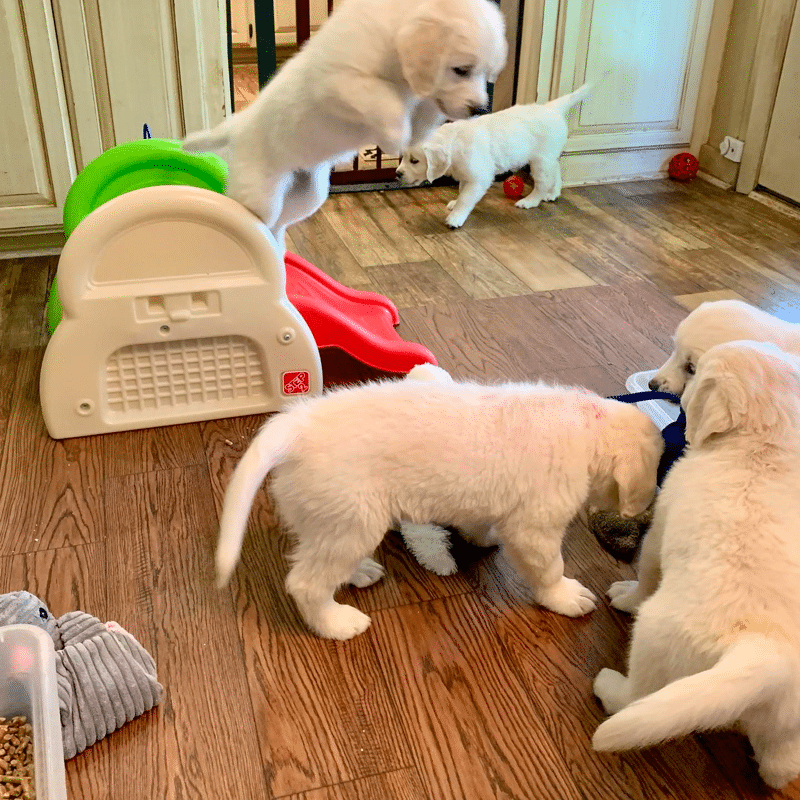
A good practice duration for a puppy’s exercise is five minutes. Basically, a puppy doesn’t need more than five minutes of exercise every month.
This means that for a 3-month-old puppy, 15 minutes of daily exercise is needed, while a five-month-old requires 25 minutes of exercise.
This is a well-structured exercise consisting of a simple game of fetch and short walks on a leash. This is an addition to the general playtime, not a replacement.
The puppies can play for as long as they want, but care must be taken not to exercise them too much.
Limits of Exercise for Golden Retriever Pup
Training and conducting agility classes do not allow puppies to compete with each other until they are at least a year older. However, they begin some basics in foundation classes, such as letting puppies get used to the equipment and learning how to move through agile tunnels. Teaching a puppy how to move through agility tunnels can help promote confidence and teach some standard skills.
Vigorous exercises, such as jumping for Frisbees or running on a hard floor, can cause the puppy’s bones to have stunted growth or to grow wrongly.
Note: Puppies should not be made to exercise by force and the amount of time spent exercising should be reduced to the time required for each puppy’s age.
Safety Tips Puppy Exercise
- Train your pups to walk with their leash.
- Start with little walks, having lots of breaks in between.
- Gradually increase the duration of the walks.
- On a hot or cold day, try to avoid walks.
- Try to move on softer floors, avoiding sharp or rocky surfaces.
What to avoid when training your pups
It’s normal for humans to think that pups can run without resting, but that’s not the case.
In order to grow into strong and healthy adults, it is necessary that you give them proper training. Here are a few things to avoid:
- Jogging or running with your pup that has its leash on.
- Catching Frisbees.
- Too much catching and throwing of balls
- Fast pacing walks.
- Take walks on humid days.
- Running with a pup alongside bikes.
- Running immediately after eating (could cause bloating).
Before exercising your pups, you should:
- First find out just how much exercise your pup really needs at its age.
- Always check the temperature outside to prevent overheating. Hot walkways can also damage your puppy’s paw.
- Time your feedings so your pups do not eat immediately after or before exercises.
- Ensure they wear the proper collar or tags always.
- Ensure they are comfortable with their leash or collars.
- Pups under 3 months probably aren’t vaccinated so do ensure exercising in public places should be limited.
And why exercise your pups, follow these simple rules:
- Try to walk at a normal pace.
- Walk the pup for the amount of time required for its age.
- Follow the puppy’s pace, stop when it stops and walk when it gets back up and is ready to continue.
- Do not walk too far away from home, just in case your pup gets too tired to keep on.
- Always try not to over-exercise your dog.
You can equally remove the leash and let the puppy exercise freely. Let your pet play freely in a safe environment such as a designated dog park or backyard. Taking the leash off is a great way for your pups to adjust their own pace and exercise the way they prefer.
- Be on the lookout for clear signs of tiredness such as; panting, reducing their pace, and lagging behind.
- Also watch out for signs of overheating such as; agitation, vomiting, drooling, or panting.
- If you are in snowy areas, avoid patches made of salt or ice melt as it can sting the puppy’s paw.
- Always keep your pups dehydrated.
After your Golden retriever pup finishes exercising, make sure you offer them plenty of clean and fresh water and give them time to relax.
After they have been well-rested, you could feed them or offer them a healthy treat.
Other Exercises for Your Golden Retriever Pup
Coupled with giving your puppy short daily walks, there are several other forms of exercise that the puppy enjoys.
Swimming
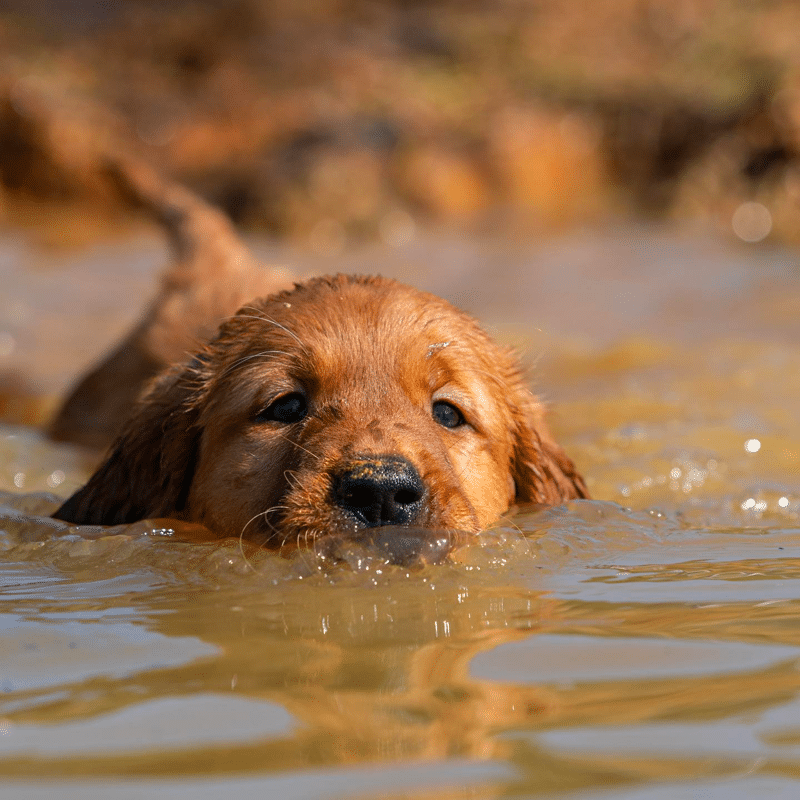
This is a great exercise for all dogs as it helps tone and strengthens the muscles. It is an easy exercise that does not stress the joints.
When you are three months old, put your puppy in water, and Get them familiar with it. Let them move in the water at a little pond, waterfront, or doggy pool. However, it is not so safe to put them in the deep waters.
Fetch
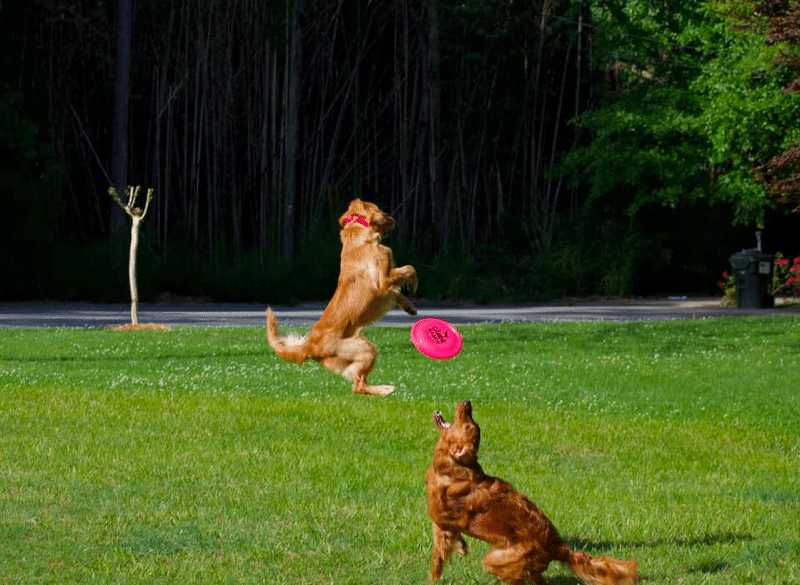
A golden retriever is designed to fetch, so great fetch games come naturally. But be aware of signs of fatigue.
Puppy toys that could move
There is a large range of interactive toys meant for pups that are very exciting and could help with exercises.
Playdate with other dogs
Having your pup around other pups, you can give them a training partner while they build on some necessary social skills.
Catch
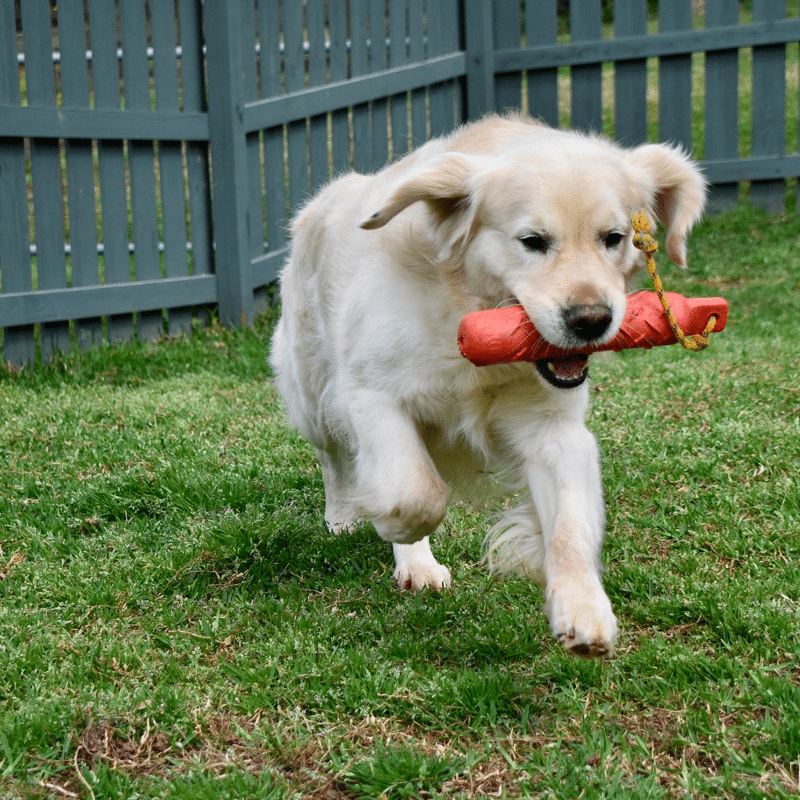
For those who have ever heard that Golden Retrievers dogs don’t know how to fetch, we are here to provide another opinion. Golden retrievers naturally know how to retrieve, but they need to be taught to catch from an early age.
How do you know if your pup is getting way too much exercise?
Exercises help promote a good range of motion. Keep joints limber, maintain muscle mass, and prevent injuries. However, if it is too much, your pup can actually get injured.
Therefore, it is really important to give your pup the right amount of exercise and not over-exercise them.
So, lookout for signs of over-exercising such as; joint injury, behavioral changes, and sore muscles.
Sore muscles indicate that the puppy is exercising too much. Here are some signs that your puppy’s muscles sore:
- Struggling to get up after laying down.
- Struggling or simply refusing to climb up or downstairs.
- Not eating because it hurts a lot to lower down.
If you do notice any signs of pain, give them enough time to relax and reduce the total amount of exercise they get. Continued exercises at this stage would result in injury.
Changes in Behavior
Now if your pup usually finds it interesting to go on walks with you, but suddenly begins to shy away from walking or whines when you start to walk, this is a sign that something is definitely wrong somewhere.
Inconsistent conditioning may lead to injuries and or behavioral changes.
If you let the puppy play on the leash, they may not get the proper exercise because it is in their nature to run in bursts, rest, and then start all over. So if they’re used to taking such breaks, it’ll always be difficult for them to take long walks and they definitely can’t enjoy them.
Joint Injury
About 60% of a dog’s body weight is carried by their forelegs, which can put so much strain on these joints. The negative effect of this extreme exercise may strain or sprain the puppy’s joints. When a puppy has a joint injury, the puppy will drag or favor one foot over the other.
Another sign that seems to be a sign of joint injury is when you notice that your dog is bowing when walking on a good foot, but raising his head while walking on a bad foot.
Heat Exhaustion
Heat exhaustion becomes a problem in the warm season. Young dogs have a hard time regulating body temperature, so excessive exercise can lead to overheating.
Signs of heat exhaustion include drooling, excessive panting, and lack of interest in feeding.
Wear & Tear on Paws
Long walks on concrete can give a sandpaper-like feeling to the puppy’s feet. Sudden stops can scrape your puppy’s bottom foot and may wear the outer part/layer of the pad. It’s good to listen patiently to the dog’s cues rather than pulling the dog while it’s tied to the leash.
If you take a look under the puppy’s paw and notice cracks, redness, visible skin flaps, and thinning, it indicates that his paw is being overworked.
For hyperactive puppies like the golden retrievers, the play seems to be more important to them than the paw pain that they feel, so they often run around despite feeling hurt around their paws.
Whew! We’ve spent quite some time on Golden retriever pups, but that’s only natural since they are still very little and hence very delicate. Adult Golden retrievers need a little more basic care.
Required Amount of Exercise for an Adolescent Golden Retriever
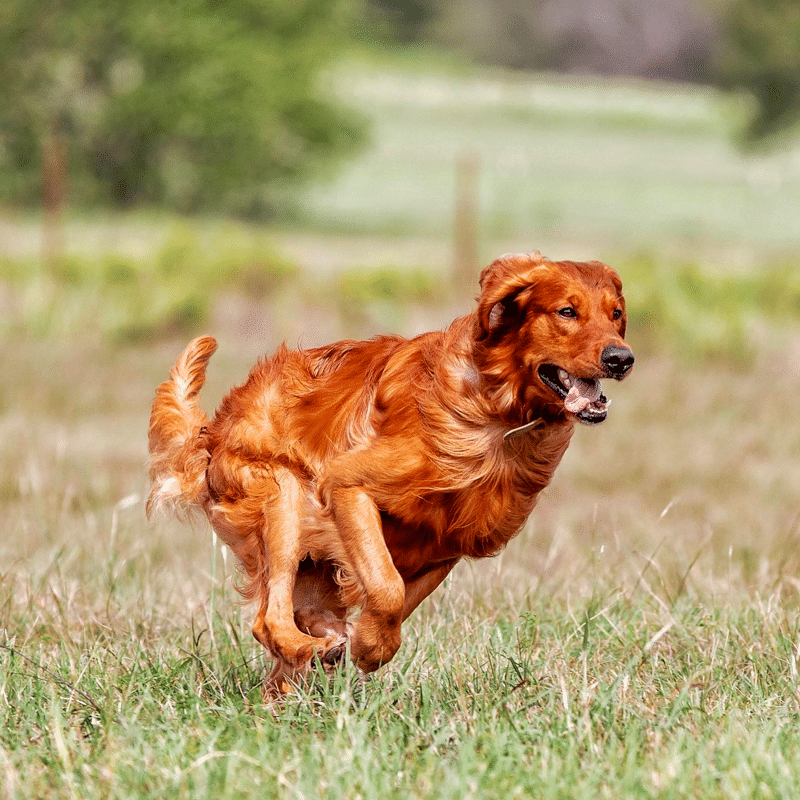
Well, a general rule suggests that healthy adult golden retrievers need an hour of exercise each day. But the breed of your dog may mean that you may need to increase or reduce this.
Retrievers from a working line are more active and probably need higher exercise, maybe up to 2 hours a day. While those from a show line would manage a 45 minutes exercise.
There really is no hard or quick rule, but giving your Golden retriever adult an hour every day is a great start. You could always increase it when necessary.
However, all goldens need to exercise often, at least two times a day. Otherwise, it can become boring and very destructive. Try offering different types of exercises, such as walking, running, swimming, and fetching. You need to excite your heart, muscles, and mind.
Don’t worry about over-exercising with a physically fit golden! They can take every physical activity you fling at them and still do more. As you will get tired long before they get tired themselves!
A Sample Adult Golden Retriever Schedule
As I established earlier, different Golden retrievers have different energy levels. But on average, here’s what a Golden retriever’s daily exercise schedule should look like:
- At 6 am – Take a 15-minute walk.
- At 11 am – Take a 15-minute walk.
- At 11:15 am – 15-minute Training/Play Session.
- At 5 pm – 20-minute play session.
- At 5:30 pm – 20-minute play Session.
- At 8 pm – 15-minute walk.
- At 8:15 pm – Play Session (Mostly fetch or Tug in the house).
This schedule was created for an average Golden of a year and some months old. It might vary depending on your Golden retriever’s age.
It sums up to about two hours of physical activity a day, but don’t worry if your golden retriever adult needs more, he`ll sure let you know.
Ways to Exercise Your Adult Golden Retriever
Now that you have a good idea of how much exercise your Adult Golden Retriever needs and what might happen if you don’t exercise them enough, here are the various ways to exercise your Adult Golden Retriever.
But before jumping into that list, it’s important to know that exercising Golden isn’t just about physically tiring them.
Mental exercise is just as important as physical exercise because they are smart dogs;
1. Play Fetch with Your Golden
Again, it’s in their name, Play fetch with your adult Goldens cause that’s what they love to do. Chasing tennis balls and Frisbees.
2. Give You Golden’s Puzzle Toys
Puzzle toys are a great way to get out excess energy from a Golden retriever. I sometimes enjoy taking out some of my Golden’s food, soaking it in water for ten minutes, putting it in a Kong, putting some peanut butter at the opening, and then freezing it. Seems like a lot, but it takes the Golden a lot of mental energy to figure out how to get all of the kibbles out, so it works as a mental exercise.
Other puzzle toys you could try include the Kong Wobbler, snuffle mats, and food balls.
3. Take your Golden’s on Regular Walks
Of course, the walk shouldn’t be intense, but letting the goldens sniff their heart out a walk helps ensure that some of their physical and mental energy is exhausted.
4. Play Hide and Seek
This is a great game that combines some training and a little exercise, but first, your Golden needs to know how to stay.
5. Take Your Adult Golden Retriever Swimming
Swimming definitely puts a strain on your ‘golden’, and it’s good for joints as there isn’t any impact. Goldens are prone to hot spots, so do make sure you dry them off completely.
How Much Exercise Does Your Older Golden Retriever Really Need?
Some goldens suffer from arthritis and others suffer from joint pain as they get older. If that’s the case for your golden retriever, talk to your local veterinarian and do follow their advice. Some exercises can make things worse and you don’t want that for your senior golden retriever.
Other dogs may begin to get slower on their eighth birthday, but some are surprisingly active after the age of 12 or more.
Dogs could be regarded as individuals just like humans are and they age differently. So be careful not to overwhelm your senior dog.
They are breeds that aim for attention, and honestly, if you ask them for too much, they do anything to obey you, and that could definitely tire them, and maybe cause more harm in the process.
It’s probably time to slow down the exercise if you’re watching your golden and he’s in pain, looks tired, or takes a much longer time to recover. You can still run and swim long distances, but avoid jumping over hedges or them chasing the ball for a whole hour.
Here are some tips to help when exercising your elderly dogs:
1. Always check with your vet, before changing your daily exercise routine.
When it comes to exercising older dogs, it’s a good idea to make an appointment with your vet before changing their exercise routine. I advise you to write down your questions and concerns before booking so you don’t miss anything.
Your veterinarian can access your dog’s condition and help you develop an exercise routine suitable for your dog.
2. Try to enjoy daily routine walks together.
A daily walk is advised for all dogs. Older dogs are no exception. Your elder dog may no longer be able to hike with you for 4 hours, but he can still enjoy a nice walk around the neighborhood. If things start to get a little mundane, you can make your dog walk more enjoyable by making your dog a navigator or taking regular sniffing breaks.
If your golden retriever is out of shape or has movement problems, don’t forget to stick to flat surfaces like neighborhood walks, to ease your dog.
3. When starting a new routine, try taking it easy.
When it comes to training older dogs, don’t forget to take it slowly when starting a new routine. Like us, our dogs can overwork themselves when exercising, especially dogs that are out of shape from the beginning. Remember to take your time and increase your activity slowly to avoid injury.
When starting a new walking routine with your dog, start on a flat surface and slowly increase distance and pace over time.
When introducing some new activities into their routine (such as swimming or fetching games), keep track of how long they have been active and if there are any signs of discomfort after that. After a few sessions, you’ll have a pretty good idea of how much activity they can handle and you can start building it over time.
When it comes to introducing exercise into your senior dog’s routine, don’t forget to take it slowly. Endurance and stamina build up over time. Gradual increases can help your dog avoid injuries.
4. Always give your golden retriever a warm-up.
One of the most important parts of dog training is to start with a warm-up. My golden, Nara, is very stiff in the morning due to her arthritis, so we take a few laps around the garden to relax before going out for a walk in the morning.
If your Golden Retriever has mobility problems such as arthritis, take a walk in the yard for 2-3 minutes to start getting them moving.
5. Only stick to low-impact exercise.
Treatment of arthritis in dogs is something that many of us have to do at some point in the dog’s life, as 80% of dogs suffer from arthritis by the age of eight.
Not everyone is happy with the diagnosis, but not all the fun activities they once enjoyed are over. Low impact exercises such as walking and swimming are ideal for dogs with movement disorders such as arthritis.
If your dog has mobility problems, stick to gentle exercises such as swimming, walking, indoor play, and gentle play sessions. These types of activities help keep your dog’s muscles strong while going easy on their joints.
Dogs with mobility problems should avoid strenuous exercises such as jogging and strenuous fetch games that rely on running and jumping.
6. Add some mental exercise to your dog’s exercise routine.
One way to keep your elder golden retriever active in their older years is to supplement his exercise routine with extra mental stimuli. Simple nose-working games like finding treats and simple hide-and-seek games continue to engage the dog’s brain while encouraging the golden to work indoors.
Add some games and activities throughout the day to help your dog enjoy indoors. Easier ways to give your dog more emotional stimulation include food dispensing toys, stuffed kong, and hide-and-seek during your daily walk.
7. Watch out for signs your dog is in pain.
When starting a new training routine with your dog, be aware of the following signs of discomfort and pain: limping, or the desire to stop or slow down. If your dog shows signs of discomfort, give them time to rest and adjust your routine as needed.
Golden retriever dogs usually do not whine or cry when they are in pain. Therefore, it is important to pay attention to body language and behavior when starting a new training routine. Contact your veterinarian if you have any questions or concerns. They can push you in the right direction when it comes to accessing the right activity level for your dog.
8. Always follow your routine consistently.
Remember to be consistent when it comes to training your older golden retriever. A 20-minute walk a day is better than a two-hour walk on the weekend. Dogs that do not exercise regularly are more likely to get injured than dogs that exercise regularly every day.
And when I say consistent, I don’t mean you have to do exactly the same thing every day (if it’s fun, it’s not a bad thing), it’s the amount and intensity of the exercise your older golden retriever does daily that you need to track.
You can mix the routine itself to keep things fun and interesting. You can take a new route for your daily walk or fetch in the park instead of the backyard. If dog brain games are part of your routine, mix them together. Hide and seek on Monday, trick training on Tuesday, and hide the treats on Wednesday.
9. Treat your older Golden Retriever to a regular massage.
A proper 10-minute dog massage will help calm your dog’s muscles after training by reducing stiffness and pain, lowering their blood pressure and improving circulation.
10. Find an exercise routine that works for your elder retriever.
Each Golden Retriever is different and when it comes to training senior dogs, it’s important to have the right balance. If your dog is accustomed to walking for 20 minutes each day, try adding 5 minutes to your routine or a short, calm play session every night. Then pay attention to the dog’s behavior, look for signs of pain and discomfort, and slowly increase the dog’s activity over time.
For dogs with joint problems such as mobility and arthritis, stick to low-impact exercises such as walking or swimming. For my dog with arthritis, the right balance for us was a combination of low-impact exercise and lots of psychologically stimulating play.
Make a note of how much your dog exercises each day and adjust as needed. If your dog shows signs of discomfort, slow down a bit and re-adjust. And as always, if you have any questions or concerns, don’t be afraid to contact your vet.
Conclusion
The Golden Retriever is a high-energy sports breed and requires a lot of exercises.
If it is lacking, it can lead to various health problems such as hyperactivity disorders and behavioral problems. For healthy and happy dogs, and for their owners, provide your beloved puppy with as much physical activity as they need and deserve!
If you like to sit up in front of the TV and stay at home, the Golden Retriever isn’t the right breed for you.
But if you’re a sporty outdoor type, you have the perfect dog! So, follow the guide in this article, and make your beloved golden retriever more healthy, active, and generally happy!
Golden Retriever Resources and Recommendations
- Golden Retrievers: History, Types, Temperament, Health and Behaviors
- Types of Golden Retrievers: Decoding Their Colors and Patterns
- How Long Do Golden Retrievers Live?
- Full Breakdown Cost to Buy and Raise A Golden Retriever
- 6-Week-Old Golden Retriever: Developmental Milestones to Expect
- 8-Week-Old Golden Retriever: Growth, Developmental and Behavioral Expectations
- 3-Month-Old Golden Retriever: Training, Feeding, Sleeping
- 4-Month-Old Golden Retriever: Training, Feeding, and Behaviors
- 5-Month-Old Golden Retriever: Behaviors, Feeding, and Training
- 6-Month-Old Golden Retriever: What to Expect from Canine Adolescence
- 7-Month-Old Golden Retriever: Full-Blown Adolescence
- 8-Month-Old Golden Retriever: Behavior, Training and Development
- 23 Essential Things to Buy for Your New Golden Retriever Puppy
- Complete Beginner’s Guide to Train Your Golden Retriever Puppy
- Golden Retriever Common Health Issues: Symptoms, Treatments, and Prevention
- How Much Exercise Golden Retrievers Actually Need (Puppies, Adults, Seniors)
- Do Golden Retrievers Shed A Lot? And What to Do
- At What Age Does A Golden Retriever’s Teeth Develop and Grow?
- Golden Retrievers are Smart, Savvy, and Adorable
- Are Golden Retrievers Hypoallergenic?
- How to Find Reputable Golden Retriever Breeders
